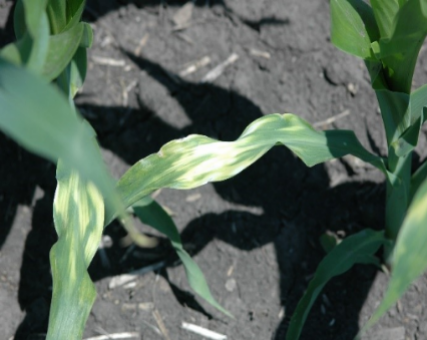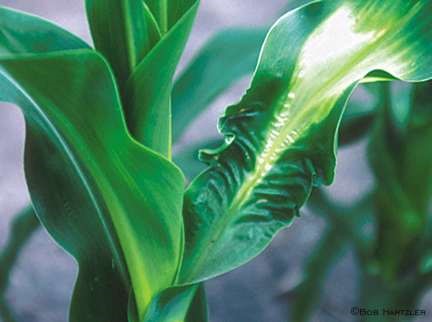- To optimize the length of residual weedcontrol, preemergence residuals should be applied as close to planting aspossible.
- Preemergent residual control is particularlyimportant for problematic weeds such as waterhemp and giant ragweed, to name afew.
- Residual herbicides should include multiple effective sites of action on the targeted problem weed(s) atrecommended label rates.
- Organophosphate (OP) insecticides tankmixed with certain herbicides can be injurious to crops.
Weed resistance has made weed management morechallenging year after year. Waterhemp, one of the most common tough to controlweeds, has documented resistance to some of the more common sites of actionavailable; ALS (i.e. Pursuit®), EPSPS (i.e Roundup PowerMax®) and PPOinhibitors (i.e. Cobra®), to name a few. We have put a lot of emphasis onwaterhemp control, and rightfully so, but we are starting to see someresurgence of more competitive weed species such as common cocklebur, giantragweed, and velvetleaf. The challenges presented in 2019 that included preventedplant acres and weeds left unmanaged, may have left a vast amount of weed seedin the soil seed bank for 2020.
Herbicide programs are most successful when theymaximize their residual potential in-crop, and when they include multiple effective sites of action on the targeted weed(s). Maximizingthe residual potential simply means that you don’t want to apply yourpreemergence residual too far ahead of your planting date. A preemergenceresidual provides the greatest return on investment when applied right beforeplanting, or within 3 days of planting the crop. Remember that generally, whensoil temperatures are above 50°F, herbicides are prone to degradation,resulting in less active ingredient in solution for residual weed control. Tomitigate some of the pressure on the POST herbicide and to best utilize thefull length of the residual, it is critical to apply that preemergence residualat planting, or as close to planting as possible.
Using multiple effective sites ofaction is recommended for best management practices (BMP’s) for weed resistancemanagement, and to help broaden the spectrum of control. Multiple effectivesites of action help to delay the onset and spread of herbicide resistance. Forexample, applying a preemergent premix containing a PPO inhibitor and an ALSinhibitor will provide one effective site of action on waterhemp (PPO), whilethe ALS inhibitor will be effective on large seeded broadleaf weeds like giantragweed. Ensuring that you have multiple effective sites of action in the tankwill help alleviate some of the pressure on the POST herbicides. Let the PREherbicides “thin the heard.”
Corn preemergence residuals are typically easier topredict. Most times the tank mix will include atrazine with either an HPPDinhibitor or a Long Chain Fatty Acid (LCFA) inhibitor, and sometimes both.Atrazine is effective on a large range of weed species, including waterhemp andlarge-seeded broadleaf weeds, while the HPPD and LCFA inhibitors are also veryeffective on waterhemp, typically our most problematic weed.
Be aware that the use of certain organophosphate (OP)insecticides for below ground insect control mixed with certain preemergenceherbicides such as ALS, HPPD or PPO inhibitors, can result in crop injury. Thisis due to OP insecticides and certain herbicides utilizing the same metabolic detoxificationpathway, resulting in a toxic buildup of these products. With some combinations,the injury can be detrimental to grain yield, while other combinations mayresult in only a temporary superficial injury (Figs. 1 & 2). Pyrethroidinsecticides may provide a safer alternative to OP’s when ALS, HPPD or PPOherbicides are used. Remember to always read and follow the label and make sureyou cross-check compatibility of your herbicide program against any at-plantsoil applied insecticides. This alsoapplies to any post-emergent insecticide applications that are planned or madein response to a pest outbreak, as there is usually a wait period to when it issafe to use certain OP insecticides following a preemergence herbicideapplication.
As the spring season approaches it is important tokeep in mind that successful weed management requires several BMP’s. One ofthose BMP’s is the use of a preemergence residual with multiple effective sites of action on the targeted problem weed species. It is also imperative toapply that preemergence residual as close to planting as possible, to gaingreater weed control for a longer period in crop. Without the use ofpreemergence residuals, weed control will most likely be poor or ineffective.For more information on weed resistance management contact your local FS CropSpecialist.

Fig. 1 above: HPPD herbicide + OP insecticide injury on corn. (source: Dr. Aaron Hager; University of Illinois)

Fig. 2: above ALS herbicide + OP insecticide injury to small corn. (source: Iowa State University Extension)